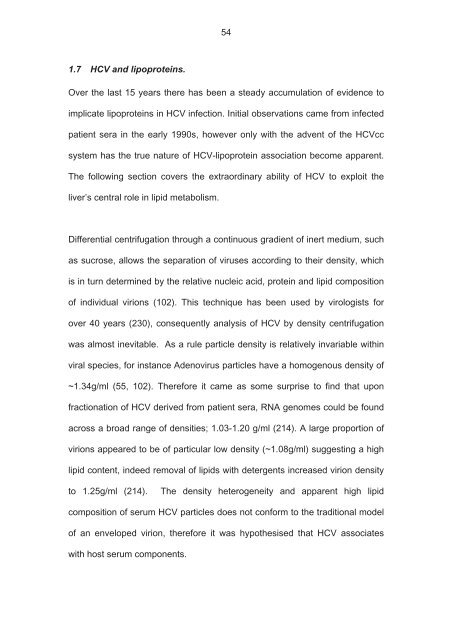The role of scavenger receptor BI in hepatitis - eTheses Repository ...
The role of scavenger receptor BI in hepatitis - eTheses Repository ...
The role of scavenger receptor BI in hepatitis - eTheses Repository ...
You also want an ePaper? Increase the reach of your titles
YUMPU automatically turns print PDFs into web optimized ePapers that Google loves.
1.7 HCV and lipoprote<strong>in</strong>s.<br />
54<br />
Over the last 15 years there has been a steady accumulation <strong>of</strong> evidence to<br />
implicate lipoprote<strong>in</strong>s <strong>in</strong> HCV <strong>in</strong>fection. Initial observations came from <strong>in</strong>fected<br />
patient sera <strong>in</strong> the early 1990s, however only with the advent <strong>of</strong> the HCVcc<br />
system has the true nature <strong>of</strong> HCV-lipoprote<strong>in</strong> association become apparent.<br />
<strong>The</strong> follow<strong>in</strong>g section covers the extraord<strong>in</strong>ary ability <strong>of</strong> HCV to exploit the<br />
liver’s central <strong>role</strong> <strong>in</strong> lipid metabolism.<br />
Differential centrifugation through a cont<strong>in</strong>uous gradient <strong>of</strong> <strong>in</strong>ert medium, such<br />
as sucrose, allows the separation <strong>of</strong> viruses accord<strong>in</strong>g to their density, which<br />
is <strong>in</strong> turn determ<strong>in</strong>ed by the relative nucleic acid, prote<strong>in</strong> and lipid composition<br />
<strong>of</strong> <strong>in</strong>dividual virions (102). This technique has been used by virologists for<br />
over 40 years (230), consequently analysis <strong>of</strong> HCV by density centrifugation<br />
was almost <strong>in</strong>evitable. As a rule particle density is relatively <strong>in</strong>variable with<strong>in</strong><br />
viral species, for <strong>in</strong>stance Adenovirus particles have a homogenous density <strong>of</strong><br />
~1.34g/ml (55, 102). <strong>The</strong>refore it came as some surprise to f<strong>in</strong>d that upon<br />
fractionation <strong>of</strong> HCV derived from patient sera, RNA genomes could be found<br />
across a broad range <strong>of</strong> densities; 1.03-1.20 g/ml (214). A large proportion <strong>of</strong><br />
virions appeared to be <strong>of</strong> particular low density (~1.08g/ml) suggest<strong>in</strong>g a high<br />
lipid content, <strong>in</strong>deed removal <strong>of</strong> lipids with detergents <strong>in</strong>creased virion density<br />
to 1.25g/ml (214). <strong>The</strong> density heterogeneity and apparent high lipid<br />
composition <strong>of</strong> serum HCV particles does not conform to the traditional model<br />
<strong>of</strong> an enveloped virion, therefore it was hypothesised that HCV associates<br />
with host serum components.

















